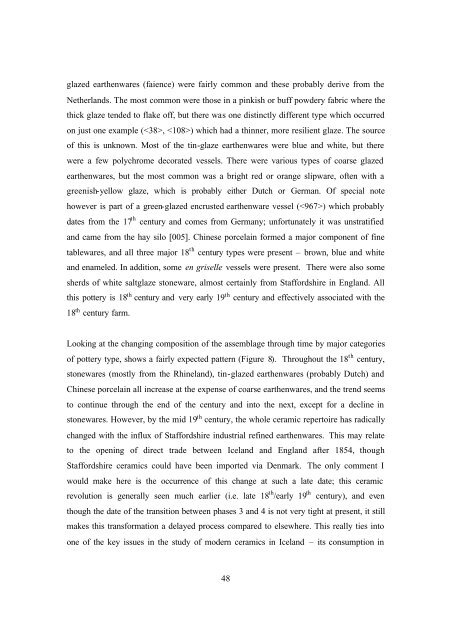Skáholt 2002 - Nabo
Skáholt 2002 - Nabo
Skáholt 2002 - Nabo
Create successful ePaper yourself
Turn your PDF publications into a flip-book with our unique Google optimized e-Paper software.
glazed earthenwares (faience) were fairly common and these probably derive from the<br />
Netherlands. The most common were those in a pinkish or buff powdery fabric where the<br />
thick glaze tended to flake off, but there was one distinctly different type which occurred<br />
on just one example (, ) which had a thinner, more resilient glaze. The source<br />
of this is unknown. Most of the tin-glaze earthenwares were blue and white, but there<br />
were a few polychrome decorated vessels. There were various types of coarse glazed<br />
earthenwares, but the most common was a bright red or orange slipware, often with a<br />
greenish-yellow glaze, which is probably either Dutch or German. Of special note<br />
however is part of a green-glazed encrusted earthenware vessel () which probably<br />
dates from the 17 th century and comes from Germany; unfortunately it was unstratified<br />
and came from the hay silo [005]. Chinese porcelain formed a major component of fine<br />
tablewares, and all three major 18 th century types were present – brown, blue and white<br />
and enameled. In addition, some en griselle vessels were present. There were also some<br />
sherds of white saltglaze stoneware, almost certainly from Staffordshire in England. All<br />
this pottery is 18 th century and very early 19 th century and effectively associated with the<br />
18 th century farm.<br />
Looking at the changing composition of the assemblage through time by major categories<br />
of pottery type, shows a fairly expected pattern (Figure 8). Throughout the 18 th century,<br />
stonewares (mostly from the Rhineland), tin-glazed earthenwares (probably Dutch) and<br />
Chinese porcelain all increase at the expense of coarse earthenwares, and the trend seems<br />
to continue through the end of the century and into the next, except for a decline in<br />
stonewares. However, by the mid 19 th century, the whole ceramic repertoire has radically<br />
changed with the influx of Staffordshire industrial refined earthenwares. This may relate<br />
to the opening of direct trade between Iceland and England after 1854, though<br />
Staffordshire ceramics could have been imported via Denmark. The only comment I<br />
would make here is the occurrence of this change at such a late date; this ceramic<br />
revolution is generally seen much earlier (i.e. late 18 th /early 19 th century), and even<br />
though the date of the transition between phases 3 and 4 is not very tight at present, it still<br />
makes this transformation a delayed process compared to elsewhere. This really ties into<br />
one of the key issues in the study of modern ceramics in Iceland – its consumption in<br />
48
















